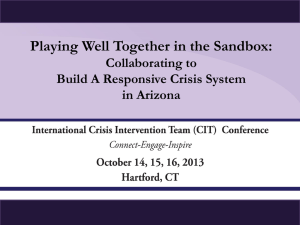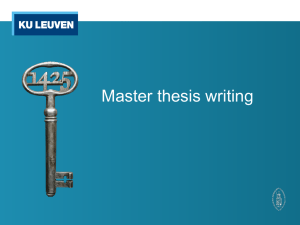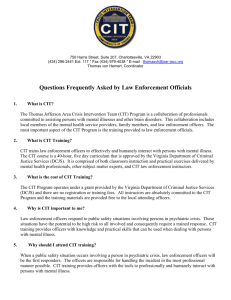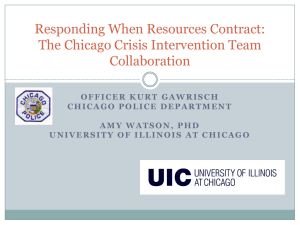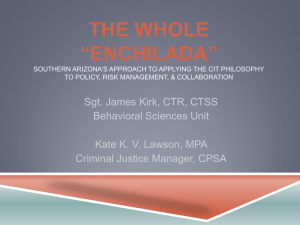Crisis Intervention Teams
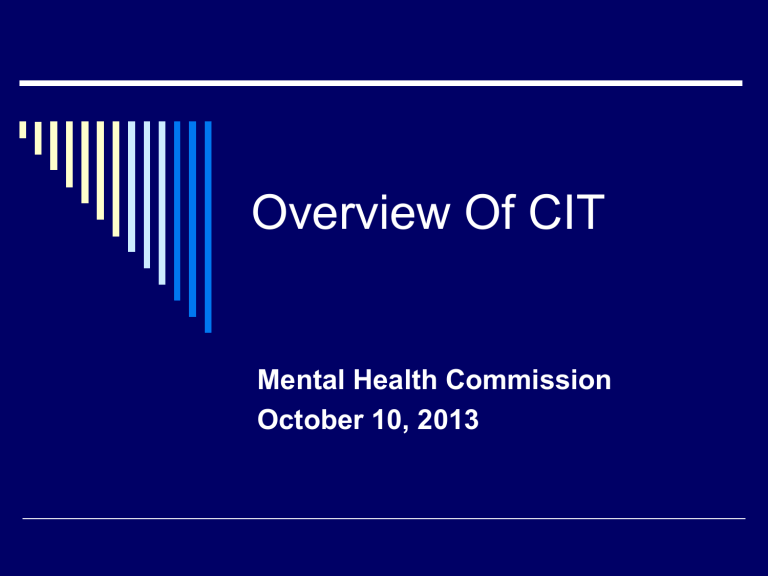
Overview Of CIT
Mental Health Commission
October 10, 2013
CIT History
Brief History
Full Program —NOT JUST TRAINING
Three parts of CIT
Additional Training for Law Enforcement
CIT Council-Problem solving and
Collaboration
Jail Diversion Program
CIT Goals
Improve the services to the mentally ill within our community
Improve collaboration and communication among mental health providers and first responders
Identify the mentally ill within our community that could be better served by treatment than by incarceration
CIT Goals
Give police officers the tools they need to handle crisis intervention
1.
2.
3.
4.
Increase knowledge of mental illness
Increase knowledge of community resources
Teach skills in de-escalation
Increase officer and bystander safety awareness
What CIT is Not
Quick fix to mental health problems in our community
Only a training program for law enforcement
A commitment to never use force against the mentally ill
CIT Executive Council
Should be approximately one-half law enforcement
Should have a representative from advocacy groups, mental health providers, mental health courts, probate council, juvenile, family member
Should be a manageable number
Serves as a means to organize a large group of individuals/agencies involved in CIT
Mid-MO CIT Executive Council
Three CPD officers
Three BCSD officers
Two MUPD officers
Mental Health Court
NAMI-Tim Harlan
University Hospital--Annette McDonald
Hospital Security--Randy Boehm
Boone County Legal Counsel--C.J. Dykhouse
Mid-Mo and DMH--Robert Reitz
Boone County Juvenile Office--Cindy Garrett
Burrell-Annie Juvie
Role of the CIT Executive
Council
Coordinating body of CIT Council
Actively participate in the work of the committees
Coordinate commitment to work toward 24/7
CIT officer availability
Serves as a review board that meets and discusses individual cases and formulates recommendations as needed
Assign projects to the committees as needed
Public Information source for the CIT Program
CIT Committees
Law Enforcement/Courts
Mental Health Providers/Medical
Juvenile
Family/Consumers
Training
Law Enforcement Committee
Write and approve CIT Policy for involved police agencies
CIT reporting
Identify the best way to get law violators with mental illness involved in mental health court if appropriate
Information sharing between L.E., P & P, and the courts
Mental Health Providers/Medical
Smooth process for involuntary/voluntary commitments
Getting information to first responders about available resources
Develop/strengthen law enforcement, hospital, provider linkages
Recommend emergency department policy for
CIT incidents
Look at the issue of crisis bed shortages
Information sharing
Juvenile
Identifying those in need of services at youngest possible age
Coordination of available resources for juveniles
Information Sharing
Training officers in the issues surrounding young mentally ill consumers
Family/consumers
Teaching officers about available resources for family members
Advocates
Giving feedback to officers on specific interventions
Family/consumer panels
Suggestion of issues to the CIT Council
Training
Develop and coordinate the 40 hour training for law enforcement
Develop familiarization programs for dispatchers, supervisors and other first responders
Actively search for speakers and training opportunities for CIT
Mental Health and
Law Enforcement
Totality of the circumstances must meet criteria for imminent harm.
RSMo 632.305 Detention for evaluation and treatment, who may request--procedure--duration--disposition after application.
632.305.
3. A mental health coordinator may request a peace officer to take or a peace officer may take a person into custody for detention for evaluation and treatment for a period not to exceed ninety-six hours only when such mental health coordinator or peace officer has reasonable cause to believe that such person is suffering from a mental disorder and that the likelihood of serious harm by such person to himself or others is imminent unless such person is immediately taken into custody.
Mental Health and
Law Enforcement
Imminent Harm DMH 132 Form - Law
Enforcement
Application for 96 Hour Detention and
Evaluation DMH 128 – Family
Member/Caregiver/Probate
Mike Krohn, BCSD
Thank You!!




